Ekranoplan "Eaglet"
As is known, the introduction of hydrofoils allowed significantly, in 2-3 times, to increase the speed compared with displacement ships. However, further growth has become almost impossible due to the physical phenomenon of cavitation (cold boiling from discharging) of water on the upper surface of the hydrofoil. Ships on an artificially designed air cushion by superchargers reached a speed of the order of 150-180 km / h - the level that became the limit for them due to the loss of stability of movement. Ekranoplans, supported above the surface with the help of a dynamic airbag, promised to solve the problems that arose to further increase the speed.
Back in the pre-war period, a number of experimental and theoretical studies were carried out at TsAGI, which made it possible to create a mathematical basis for the design development of existing samples. The use of the screen effect gave a dramatic increase in the economic impact of WIG compared to aircraft of comparable take-off weight and payload: for WIG, flight is possible with a smaller number of engines (or with engines of lower power) and, accordingly, with less fuel consumption than the aircraft being compared. In addition, ekranoplane flying up from the water does not need expensive airfields, which take vast territories out of land use. The advantage over the SCS (ship on hydrofoils) is at cruising speed 4-6 times the size of a ship and a much smaller crew. However, the use of WIG in military affairs seemed to be the most promising: the above-mentioned merits were attached to the latter’s secrecy - an object flying at a height of several meters is extremely difficult to detect visually or using radars, which allows the enemy to strike unexpected blows while remaining vulnerable to retaliation. Add to this the maneuverability, considerable carrying capacity, a large radius of action, resistance to combat damage — and you get an almost perfect vehicle for disembarking and supporting amphibious assault forces.
In the early 60s, work began on real prototypes for use in the military field - do not forget now about the time in which the events unfolded. The head enterprises that created a new type of technology became aviation Design Bureau named after G.M.Beriev in Taganrog (known for its seaplanes), where a group of designers led by R.L. Bartini designed a series of ekranoplanes with the designation BBA - a vertically soaring amphibian, and a ship central design bureau named after R.E. Alekseev in Nizhny Novgorod (b. Gorky), Of course, both leaders were alive at that time, and the organizations they headed were bearing different names.
Design teams are faced with a mass of intractable problems: the need to create a light and at the same time durable design that can withstand the impact of wave crests at a speed of 400-500 km / h and flight altitude not exceeding the average aerodynamic wing chord, on which the screen effect was manifested. It was necessary to develop the necessary materials, since the shipbuilding plants were too heavy, and the aircraft did not withstand contact with salt water and quickly corroded. The end result was impossible without reliable engines - this work was carried out by a well-known engine-building company, headed by N. D. Kuznetsov, who prepared special marine modifications of the widely used turboprop - NK-12, and turbo-jets - NK-8-4 aircraft engines operating on An- 22 "Antey", Tu-95, Tu-154 and many others.
It should be noted that attempts to create an ekranoplane were made not only in the USSR, but also in other countries of the world: Finland, Sweden, Switzerland and Germany, the USA.
However, the need for a huge amount of research and development, comprehensive mock-up and full-scale studies - in the absence of confidence in the ultimate success - led to the collapse of development at the termination of public funding. This is how a situation that is unique and at odds with stereotypical concepts took shape: unlike most other cases, where the priority in creating something belonged to Russia, and then due to the unruly state-bureaucratic machine, the WIG, as a type of technology invented by the Finns, received due the assessment of the “party and government”, the design bureaus, which developed the work on the creation of combat vehicles, enjoyed unlimited support and funding. The corresponding state program was adopted, where the customer was the USSR Navy.
And if in Taganrog after the death of Robert Bartini - a talented engineer, a descendant of the Italian aristocratic family, according to his communist convictions, he was forced to emigrate in 1923 in the USSR, work on the BBA-14 designed under his leadership was stopped, in Nizhny Novgorod the development and construction took the widest scope. They were conducted in several main areas: an attack missile carrier with cruise missiles on board, an airborne transport ekranoplan, a patrol anti-submarine vehicle. At the same time, the terminology was clarified: ships that could fly only on a screen cushion began to call ekranoplans, while those with the ability to go onto purely aircraft modes were designated as E-guns.
Ekranoplan VVA-14
After a series of experiments with models in which a basic layout scheme was worked out, ten prototypes were sequentially constructed with a gradual increase in size and take-off weights. The top of the found aerodynamic solution was the KM built in 1963, the ship was a colossal size: longer than 100 m, the wingspan of 40 m and take-off weight over 540 t. At the end of 60-s American photographers photographed it, and in the West KM received nicknamed "The Monster of the Caspian Sea" for its unusual predatory appearance. The ekranoplan was comprehensively tested for over fifteen years and proved the full viability of this type of equipment. Unfortunately, in the 1980 year, due to a piloting error, it crashed, resulting in significant damage, and sank.
Continuing the development line, in 1972, the Orlyonok ekranolet, designed to transfer naval assault forces to a range of up to 1500 km, was launched for sea (flight) tests. "Eaglet" is able to take on board up to 200 marines with full armament or two floating tank (BTR, BMP) with crews, take off from the wave up to 2 meters and at a speed of 400-500 km / h deliver troops to the landing site. For him, any protective barriers - mine and network - are not an obstacle - he just flies over them. After landing on water and going to a relatively gentle coast, Eaglet lands people and equipment through the bow that leans to the right. In tests, in one of the test flights, the ekranolet showed amazing survivability, receiving fatal injuries for the ship, and even more so for the aircraft. From the impact on the water at the "Eaglet" came off feed with a keel, horizontal tail and marching engine NK-12MK. However, the pilots were not taken aback, and, increasing the speed of the nose takeoff and landing engines, did not allow the ekranolet to plunge into the water and brought the car to the shore. The cause of the accident, apparently, were cracks in the rear of the hull, received during previous flights and not noticed in a timely manner. On new specimens, the fragile structural material K482T1 was replaced with aluminum-magnesium alloy AMG61. In total, five eagle-type ekranolets were built: “Double” - for static tests; S-23 - the first flight prototype from K482T1 alloy (developed after the accident); S-21, built in 1977; S-25, assembled in 1980 and S-26, commissioned in 1983. All of them became part of the naval aviation, and on their basis the 11th separate air group of direct subordination to the General Staff of Naval Aviation was formed. One of them was also lost in 1992 as a result of a disaster during which one crew member was killed.
Ekranoplan Double
According to some reports, the state program provided for the construction of the 100 (!) "Eaglets". Finally, this figure was adjusted to 24. Shipbuilding plants in Nizhny Novgorod and Theodosia were to carry out serial assembly. However, these plans were not destined to be realized. In 1985, Dmitry Ustinov died - the Minister of Defense of the USSR and the former People's Commissar (Minister) under Stalin. At the time of Ustinov, the production of new types was actively developing. weapons in general and ekranoplanes in particular. The new Minister of Defense, Sergei Sokolov, in the past a dashing tanker and figure with a breadth of vision limited by tank triplex, closed the ekranoplan construction program, and preferred to give the funds allocated for it for expansion fleet nuclear submarines, after that the Navy lost interest in its unique unit, and the once top-secret base in the city of Kaspiysk, located on the shores of the same sea a few kilometers from the capital of Dagestan - Makhachkala, is gradually deserted - funds are allocated only for the maintenance of personnel . The flight personnel, who before arrival to the group flew mainly on Be-12 anti-submarine amphibious aircraft, has a minimum annual flight time of 30 hours - “on other types of aircraft”: ekranoplanes are not in flight condition partially due to the exhaustion of resources, partly due to the lack of the same financing, and therefore spare parts, materials, fuel.
Tarus - Anti-submarine amphibious aircraft Be-12
In the same way as the branch of the Eaglet type rocket launchers, the branch of the Lun strike bomber carriers dries up. Occupying an intermediate position in size and starting mass between KM and Orlyonok, Lun is also unique in its kind. Essentially, being a high-speed transport and launch platform for the Moskit supersonic anti-ship cruise missiles ZM80 developed by the ICB Raduga, it has the power of an on-board volley - container-type launchers - comparable to that of a missile cruiser, surpassing it in speed, in terms of X. time. The advantage in maneuverability and stealth is not necessary to say. It is also important that the cost of construction and operation of the "Lun" is much cheaper. Of course, WIGs are not capable of replacing the ships carrying rocket armament, and this was not envisaged. But for action in relatively limited water areas, such as, for example. The Baltic, Black or Mediterranean seas, the Luney squadron could effectively complement warships. Now one built shock "Lun" stands on the territory of the base in Kaspiysk, presenting a sad spectacle, evoking associations with the stuffed dinosaur, put on display in the paleontological museum. The second, according to some information, is being completed in a search and rescue variant.
Faced with the absence of the main customer, the Central Design Bureau for the SEC named after RE Alekseev is trying to catch the wind of conversion into his sails. On the basis of existing projects, civil modifications of the Orlenka and Lunya are being developed. One of them - research - MAGE (Arctic Marine Geological Survey Ekranoplan). But the main hopes are connected with two small ekranoplans: a Volga-2 boat on a dynamic air cushion (the simplest version of an ekranoplan) and a new multi-purpose Strozh screen. Both devices are built and are undergoing development tests in Nizhny Novgorod. With them, the CDB is counting on commercial success in the international market. There are already offers from Iran, the government intends to purchase a series of Swifts in patrol and patrol variant for its military fleet in the Persian Gulf. Serial production is organized at the shipyard in Nizhny Novgorod. EKRANOLET is a two-seater unit with a length of 11.4 m and a wingspan of 6.6 m. Take-off weight 1630 kg. The Swift develops a maximum speed of 200 km / h and has a range of 500 km. It is equipped with two VAZ-4133 rotary-piston engines rated at 150. with. each rotating five-bladed propellers with a diameter of 1.1 m. The design of the airframe is mainly made of aluminum-magnesium alloy.
As mentioned above, the navy of Russia does not have funds for the purchase of percussion and transport-assault ekranoletov, and although there are certain hopes for the construction of anti-submarine modifications, these hopes still look very dim in the current difficult economic and political situation. The situation with financing civilian development is no better - it was planned to allocate from the budget of 200 million rubles before the end of 1993, the amount sufficient, according to the chief designer of Orlyonok, Viktor Sokolov, to continue work, and transferred to the account of the Central Design Bureau ... two million .
Lately story with ekranoplans received a completely unexpected turn.
After analyzing the prospects of this type of technology and having come to the conclusion that, to put it mildly, the backlog of work (due to the actual absence of such) in the field of ekranoplanostroeniya, is significant, the US Congress created a special commission to develop an action plan to eliminate the “Russian breakthrough”. Commission members offered to ask for help ... to the Russians themselves and went directly to the Central Clinical Hospital for SEC, the latter informed Moscow and received permission from the State Committee for Defense Industry and the Ministry of Defense to hold talks with the Americans under the patronage of the Commission for Export Control of Arms, Military Equipment and Technologies MO RF. And in order not to draw too much attention to the subject of negotiations, inquisitive Yankees offered to use the services of an American company under the neutral name “Russian-American Science” (RAS), and with her mediation, a delegation of overseas specialists had the opportunity to visit the Central Design Bureau for SEC, to meet with ekranoplan designers, find out, if possible, the details of interest. Then the Russian side kindly agreed to arrange a visit by American researchers to the base in Kaspiysk, where they were able to capture, without any limitations, a “Eaglet” specially prepared for the flight on a photo and videotape.
Who was part of the American "landing"? The head of the delegation is Colonel of the US Air Force Francis, who heads the program for creating a promising tactical fighter. Under his leadership were prominent specialists from research centers, including from NASA, as well as representatives of American aircraft manufacturing companies. Among them, the most famous person was Bert Rutan, who designed the aircraft of the unconventional aerodynamic scheme "Voyazher", on which several years ago his brother made a nonstop round-the-world flight. In addition, according to representatives of the Russian authorities present at the show, the delegation included persons who, over the years, collected information in all possible ways about Soviet ekranoplans and for the first time suddenly had the opportunity to see with their own eyes - and even touch - the object of their close attention.
As a result of these visits, which cost 200 thousands of dollars just to American taxpayers, our new friends will be able to save several billion dollars and significantly, by 5-6 years, shorten the development time of their own ekranoplan projects. US representatives have raised the issue of organizing joint activities to eliminate their backlog in this area. The ultimate goal is to create an ekranoplan transport-assault landing vehicle with a take-off weight of up to 5000 tons for the American rapid reaction force. The entire program may require 15 billion. How much of this amount can be invested in Russian science and industry — and whether it will be invested at all — is unclear. With such an organization of negotiations, when the received 200 thousand dollars do not cover the costs of the TsKB and the pilot plant, I am worth 300 million rubles for bringing the Orlyonok to a flying state, there is no need to rely on the mutually beneficial cooperation.
The reaction of the responsible official of the Commission for Export Control of Armaments, Military Equipment and Technologies of the Russian Defense Ministry Andrei Logvinenko to the appearance of press representatives in Kaspiysk (simultaneously with the Americans) leads to doubts about the benefits of such contacts for the state interests of Russia. Officially referring to considerations of secrecy (!), He tried to prohibit journalists from entering the base, and in the private conversation that followed, he explained that his task was to prevent information leaks to the press about Russian-American contacts about ekranoplans and added that after the departure of the Americans we can shoot and write anything, but without saying a word about the American visit to the former secret object.
Who can confidently predict events that can happen in a year or two, and even more so by the beginning of the next century? It is quite possible that in a relatively short period of time the United States will deploy its fleet of high-speed and invulnerable E-flyers, in the shape of which the outlines of their Russian prototypes will be recognized, and Russia will have to take adequate measures that will cost hundreds or thousands of times more than someone expects to receive. The ideological confrontation is over, I would like to hope forever, but the geopolitical interests of America and Russia do not always coincide, and if someone has misconceptions on this subject, then this circumstance cannot serve as a basis for selling abroad at unprofitable prices information on the latest defense technologies.
Looking through the documents of the correspondence of the Central Clinical Hospital on the SEC named after R.Ye. Alekseev with numerous state institutions on ekranoplanostroeniya, you once again see how difficult it is for new unique developments to make their way. We would not have had to catch up in a few years, and let alone buy invented in the West by us, and then rejected in our own country.
Brief technical description of the landing wig "Eaglet"
The ekranoplan "Eaglet" is designed according to the normal aerodynamic configuration. This is a three-engine low-winged T-tail and fuselage-boat. The airframe design is made mainly of AMG61 alloy, as well as steel. Radiolucent surfaces - from composite materials. The protection of the airframe against corrosion is provided by electrochemical protectors and special coatings.
Fuselage. It has a beam-stringer power structure. It houses the cabin and rest room for the crew, compartments of electronic and radio communications equipment, cargo compartment length 28.0 m, width 3.4 m with power floor and mooring units, as well as the compartment of the auxiliary power unit and onboard units, providing autonomous launch of the main power unit and hydraulic and electrical systems. For loading and unloading equipment and people behind the crew cabin, a power connector is provided, with the help of which the nose of the fuselage is turned to the right side to 90 °. The bottom of the hull is formed by a system of redans and two hydraulics, on which the main and nose landing gears are mounted.
Wing. The aerodynamic layout of the wing is optimized for flying near the screen: a large angle of attack, a small - 3.25 - elongation and sweep 15 °. 5-sectional aileron flaps with deflection angles + 42 ° ...- 10 ° are installed along the trailing edge of each half-wing. Special starting shields with a forward axis of rotation and the deflection angle 70 ° are mounted on the lower surface of the consoles along the leading edge. Mechanization of the wing is used on takeoff to create a gas cushion separating the ekranoplan from the water. At the ends of the bearing planes, floats are installed with an auxiliary chassis fixed on them. Structurally, the wing consists of a center section and two consoles that have a multi-column caisson power circuit.
Tail. In order to reduce the influence of the screen on the stability and controllability of the screen, as well as to prevent water splashing into the engine and propeller blades, the T-shaped tail unit was used on the Eaglet. The stabilizer has a sweep along the leading edge of the 45 ° and is equipped with a four-section elevator. Vertical plumage 40 ° is a single unit with the fuselage.
Chassis. It consists of a two-wheeled nose and ten-wheel main bearings with non-brake pneumatics. Nasal wheels swivel. There are no support leaves. The design of the chassis together with the ski-damping device and blowing ensure maneuverability on virtually any surface: ground, snow, ice.
Power point. Includes two NK-8-4K turbojet engines (10.5 t static maximum thrust) and KN-12MK main propulsion turboprop (15.5 t static maximum thrust). The rotating nozzles of the starting engines allow jet streams to be directed under the wing in the mode of inflation (on take-off or landing), or above the wing, if it is necessary to increase thrust in a cruising flight. Starting engines by using the auxiliary power unit EA-6A. Fuel tanks are located in the root of the wing.
Systems and equipment. On board the wig mounted navigation system "Screen" with a review radar in the fairing on the rack in the upper nose of the fuselage. In the nose fairing there is an antenna of navigation radar collision avoidance with high resolution “Screen-4”. The “Eaglet” has an automatic flight control system, similar to aircraft autopilot, allowing piloting both in manual and automatic mode. The hydraulic system provides the drive of steering surfaces, wing mechanization, cleaning and release of the chassis and hydrolines, turning the flip-up nose of the fuselage. The electrical system provides the current flight-navigation, radio and electrical equipment. The ekranoplan is equipped with specific ship devices: marine navigation lights and anchor-towing accessories.
Armament. On board the "Eaglet" in a rotating turret mounted defensive double-barreled gun "Rock" caliber 14.5 mm.
SCREEN
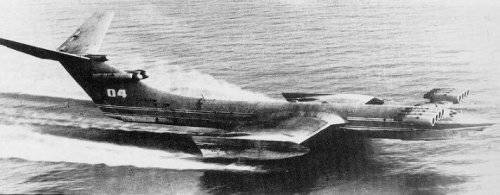
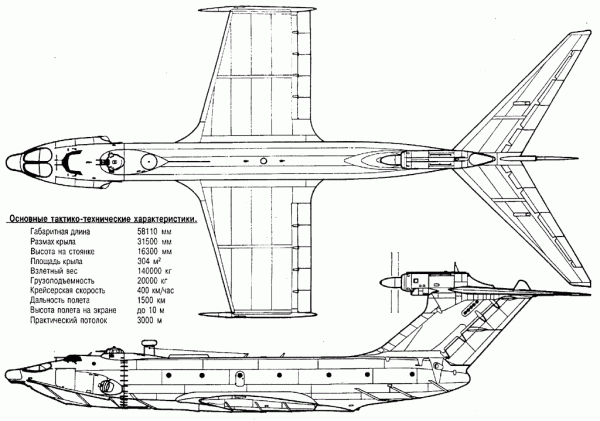
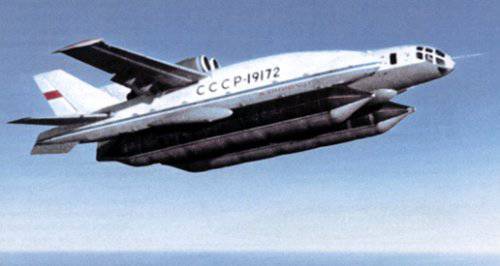
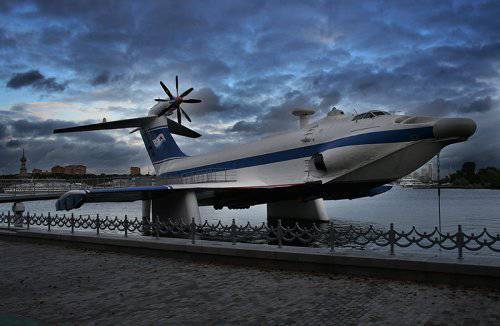
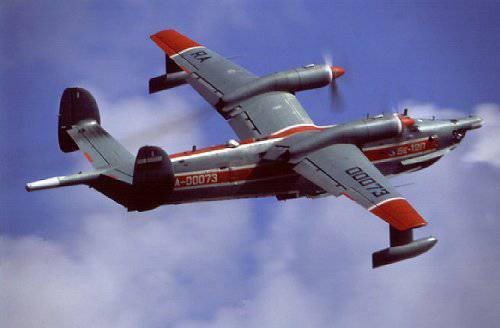
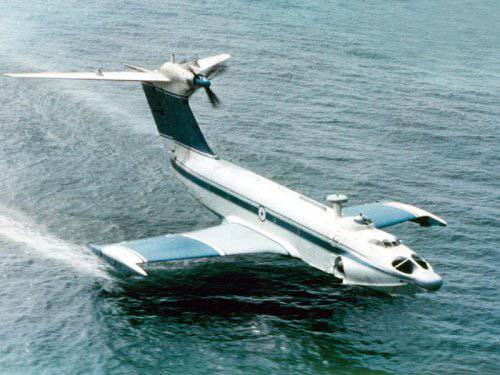
Information